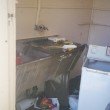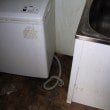B2.1 Laundry design
Washing clothes and bedding is important to residents and the laundry is likely to be in constant use. A study of laundry use recorded an average of four washing machine loads per day per house (Tietz 1994).
Therefore a laundry should provide storage space for dirty washing, ample space and services for a washing machine, laundry tub, high shelves or cupboards to store cleaning products and a place to dry clothes. Benches, cupboards, floors and wall finishes need to be robust and suited to use in a wet environment. The laundry should also be designed for use by people with disabilities.
A washing machine requires its own taps, waste outlet and power point. If only one set of taps is provided for the washing machine and laundry tub, the machine is more difficult to use, and repeated connecting and disconnecting of the hoses will wear out the fittings.
A level, sealed surface for installation of a washing machine will also reduce wear and tear on the machine by keeping the machine in balance during the washing and spin cycles.
There is no evidence that washing clothes in hot water, given domestic supply temperatures, will achieve improved health outcomes. Given that heating water is one of the major costs of running a house, discuss with the resident capping the hot water tap at the washing machine. This will make more hot water available for washing people and will probably reduce energy bills.
Laundry tubs may be used for many purposes, including storing clothes before or after washing, hand-washing clothes, washing hands, bathing young children, cleaning or filling buckets and large cooking pots, and rinsing fishing or hunting gear. Providing two laundry tubs can make it easier to carry out more than one of these activities at the same time. Avoid using tubs built-into plastic or metal cabinets that are prone to corrosion, can harbour cockroaches, and have under tub storage that is hard to secure laundry products away from young children.
Data show small improvements, since 2013, in the number of houses with secure laundry tubs 92% – up 1% and working taps to the tub, 76% hot water OK and 78% cold water OK- up 3% and 1%, respectively, for both hot and cold water tap function.
Drainage of the laundry tub remains constant, with 90% of houses tested having functioning drainage.
Wet hands, potentially wet floors and electrically powered metal washing machines increase the electrical risk in the laundry area of the house. Of the houses surveyed 86% had a functioning power point near the washing machine and 91% were safely located. Still only 52% of houses had a weather-protected power point in the laundry however this figure has risen significantly, by 7%, since 2013.
In Australian public housing, washing machines are considered the responsibility of the tenant. The number of houses with a working washing has increased by 7% to 85%, since 2013. All the services required to enable a washing machine to function have improved, some significantly, since 2013 – an adequate space for the machine, independent water taps and drainage (see detailed data).
62% of houses surveyed had a high shelf for the safe storage of washing products out of the reach of children. However the number of houses with safe storage has improved significantly, by 14%, since 2013.
Design and Specification
Ensure
- B2.1.1.
there is an accessible space for the washing machine next to the tub, that is at least 900mm wide and at least 700mm deep to suit commercial washing machines and door swings should not encroach into any of this space
- B2.1.2.
there are taps and a waste outlet, which could be a bypass on the side of the laundry tub, specifically located for the washing machine
- B2.1.3.
there is a power point near the washing machine that is located away from the tubs and above the taps to prevent contact between power cords, plug connections and water
- B2.1.4.
there is at least one 70 litre laundry tub next to the washing machine space with a hot and cold water supply, taps and spout
- B2.1.5.
the laundry tub is securely mounted and well sealed to the bench or walls to prevent water damage to the wall or floor structure
- B2.1.6.
water can drain from the laundry area floor via a floor drain or external opening when there is a plumbing failure, if the washing machine overflows and for cleaning purposes
- B2.1.7.
the grade of the floor will allow a washing machine to be placed and levelled in that position but the floor falls to the drain to prevent water pooling under the washing machine
- B2.1.8.
the entire floor area, the floor to wall junctions and the walls behind the tub and washing machine are waterproofed and lined with tiles, laminated sheet product, sheet vinyl or other water-resistant wall linings. Floor finishes should extend under Laundry cabinetry to enable cupboards to be removed without affecting the flooring.
- B2.1.9.
the floor finish is slip resistant
- B2.1.10.
high level (above 1500mm), rust-proof shelves are provided for storage of cleaning products or a secure storage cupboard.
Consider
- providing a double tub or two separate laundry tubs
- using an flush line laundry tub set into a bench and providing bench space next to the tub
- making provision for the washing of children at the laundry tub, see B.14 ‘Washing young children - baths and tubs’
- connecting the laundry taps to the hot water tempering device to prevent scalding, particularly if the laundry tub taps are also used for washing hands or children
- providing a soap holder and towel hook near the tub
- using weather protected power points and switches in the laundry with a minimum rating of IP53
- providing additional space and power points for a clothes dryer or freezer that may be kept in the laundry
- providing circulation space into and within the laundry for use by a person with a disability, 1550mm clear space in front of fixtures, and locating the taps and power points within reach for a person in a wheelchair
- providing a lockable cupboard for potentially dangerous laundry and cleaning products, and/or a tall broom cupboard or hooks for brooms and mops
- installing an advisory engraved label about the benefits of using cold water only for washing above the hot water washing machine tap
- installing a commercial washing machine as a ‘fixture’ of the house, to be maintained by the housing provider.
- dusty environments and water with high levels of mineral salt will shorten the life of washing machines. If installing washing machines in these environments consult washing machine manufacturers about factory modifications to reduce maintenance costs
- installing the washing machine onto levelled base, firmly secured to prevent movement across the floor and subsequent machine damage.
Real world examples of Solutions
-
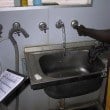 Testing laundry services
Testing laundry services -
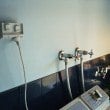 water and dust resistant power point located above good quality tapware
water and dust resistant power point located above good quality tapware -
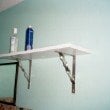 High level shelving
High level shelving -
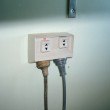 Weather resistant power point
Weather resistant power point -
 Laundry can drain to outside
Laundry can drain to outside -
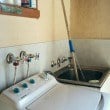 Washing machine and laundry tub tapware
Washing machine and laundry tub tapware -
 1/4 turn tap to washing machine
1/4 turn tap to washing machine -
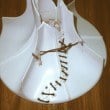 Washing machines are valued. A resident spent hours wiring this agitator to allow clothes washing.
Washing machines are valued. A resident spent hours wiring this agitator to allow clothes washing.
- B2.1.1.
Quality control
- there is a clear space that is at least a 900mm wide and 700mm deep for the washing machine with dedicated taps and specific waste water outlet, which could be a bypass on the tub

- SKETCH DESIGN
COMPLETED DESIGN & SPECIFICATION
DURING CONSTRUCTION
AT HANDOVER
- SKETCH DESIGN
- at least one 70 litre tub is installed with dedicated taps, spout and drainage, and that it is secured to and well sealed to the bench top and the wall

- SKETCH DESIGN
COMPLETED DESIGN & SPECIFICATION
DURING CONSTRUCTION
AT HANDOVER
FINAL COMPLETION
TRADE TEST
- SKETCH DESIGN
- the laundry area has been waterproofed, the floors and walls are lined with a water-resistant material and the builder has provided a warranty

- COMPLETED DESIGN & SPECIFICATION
DURING CONSTRUCTION
AT HANDOVER
FINAL COMPLETION
TRADE TEST
- COMPLETED DESIGN & SPECIFICATION
- the laundry floor is graded to drain to a floor drain or external point and water will not flow back into the house

- COMPLETED DESIGN & SPECIFICATION
DURING CONSTRUCTION
AT HANDOVER
FINAL COMPLETION
TRADE TEST
- COMPLETED DESIGN & SPECIFICATION
- there is a power point provided for a washing machine in a safe position above taps and away from the laundry tub and positioned to ensure electrical leads will not run under or over taps or near to the laundry tub

- COMPLETED DESIGN & SPECIFICATION
DURING CONSTRUCTION
AT HANDOVER
FINAL COMPLETION
- COMPLETED DESIGN & SPECIFICATION
- there is a high shelf (min. 1500mm) or lockable cupboard for laundry and cleaning products

- COMPLETED DESIGN & SPECIFICATION
AT HANDOVER
FINAL COMPLETION
- COMPLETED DESIGN & SPECIFICATION
- laundry benches, cupboards, soap holders, towel rails, additional power points and any other items that have been specified or shown on the drawings have been provided.

- COMPLETED DESIGN & SPECIFICATION
DURING CONSTRUCTION
AT HANDOVER
FINAL COMPLETION
TRADE TEST
- COMPLETED DESIGN & SPECIFICATION
- there is a clear space that is at least a 900mm wide and 700mm deep for the washing machine with dedicated taps and specific waste water outlet, which could be a bypass on the tub
Maintenance
As part of cyclical maintenance, check that:
- the taps for the washing machine and laundry tub are working and not leaking, replace washers if the taps are dripping, check the washing machine taps are not left in the fully open position by opening fully, then turning back one turn

- Plumber, Local Maintenance Team
- 12 Months
- the drains for the washing machine and laundry tub and the floor drains are working

- Plumber, Local Maintenance Team
- 12 Months
- the washing machine water supply pipes are flexible and are not leaking at either end

- Plumber, Local Maintenance Team
- 12 Months
- there is a drain pipe from the washing machine to a dedicated drain, not through the laundry tub

- Plumber, Local Maintenance Team
- 12 Months
- power points are secured to the wall and are tested as safe

- Electrician, Local Maintenance Team
- 12 Months
- the tub and surrounding bench or cabinet are secure and in good condition

- Carpenter, Local Maintenance Team
- 12 Months
- there is a plug attached by a chain, or fixed in some way, to the laundry tub.

- Local Maintenance Team
- 6 Months
- the taps for the washing machine and laundry tub are working and not leaking, replace washers if the taps are dripping, check the washing machine taps are not left in the fully open position by opening fully, then turning back one turn
Standard And References
AS 3740:2021 Waterproofing of domestic wet areas
AS1428.2 Design for access and mobility - Enhanced and additional requirements - Buildings and facilities
AS 4299–1995, Adaptable housing
AS 3958.1-2007 Ceramic tiles - Guide to the installation of ceramic tiles
AS 3958.2-1992 Ceramic tiles - Guide to the selection of ceramic tiles
NCC 2022 Part H4 Health & Amenity, and particularly - H4O1 & H4O4; H4F1 & H4F4; H4P1, H4P3 & H4P4; H4V2; H4D2, H4D3, H4D5, H4D6, & H4D7.
Centre for Appropriate Technology Inc. 1996, Our Place, 1st edn, pp. 12−13.
Tietz, C 1994, The Washing Machine Report, Transform, Waverley, New South Wales.

